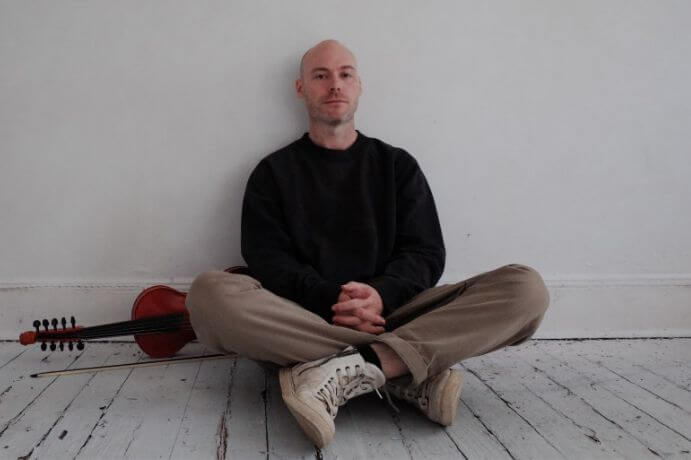ListN Up is a series of artist-curated playlists that offer an intimate sonic portrait of contemporary artists by showcasing the diverse and stylistically varied music that influences their creative practice.
Described by the Irish Times as “a musician at one with his instrument and his music,” Cleek Schrey is a fiddler, improviser, and composer from Virginia. He plays traditional music from Appalachia and Ireland and makes experimental work using composition, film, and field recordings. From March 10 to 19, Schrey’s group, The Daxophone Consort, presented Deeper Closer Warmer at HERE, in New York City. A theatrical collaboration with the Puerto Rican puppeteers Poncili Creación, the piece was described as “an ancient surgery that examines the crevices of flesh and consciousness.”
Hello. My name is Cleek Schrey. I’m a composer, improviser, fiddler, and filmmaker living in Brooklyn. The theme of my playlist is, loosely, Magic Squares. In recreational mathematics, a square array of numbers, usually positive integers, is called a magic square if the sums of the numbers in each row, each column, and both main diagonals are the same. Musicians have looked to numerology, the occult, and extraneous processes for clues on how to put music together for thousands of years. I appreciate the potential of an arbitrary process to get us out of our ears and instincts and into an adventurous abyss.
“Ma fin est mon commencement” by Guillaume Machaut, performed by Charles Daniels, Angus Smith, & Don Greig
Not a square, but a crab canon over a palindrome. Machaut (1300-1377) creates an intricate and full listening experience out of a small amount of material by simply reversing the lines in a perfect retrograde.
“The Wind Carried Him In Its Belly” by Michael Maier, from Atalanta Fugiens (1617)
Michael Maier (1568-1622) was a composer, alchemist, and epigramist who assembled an ambitious book of music and illustration called the Atalanta Fugiens. The whole book is actually a magic square, argued very persuasively by Donna Bilak, so the musical compositions in each of the 49 squares plays into the overall architecture in various ways. For more information on this work, check out this incredible resource.
“Concerto for Nine Instruments” (1934) by Anton Webern, performed by the Saint Paul Chamber Orchestra and Pierre-Laurent Aimard
Webern (1883-1945) worked for a long time on the Concerto’s row, trying to arrive at an equivalent to the Latin word-square palindrome, which reads the same left to right on the top, right to left on the bottom, downwards from top-left, and upwards from bottom-right:
S A T O R
A R E P O
T E N E T
O P E R A
R O T A S
“Concert for Piano and Orchestra” (1958) by John Cage, performed by the Orchestra of the S.E.M. Ensemble, Petr Kotik, and Joseph Kubera
As John Cage (1912-1992) made his way to using chance procedures, he began using magic squares to itemize and delineate various musical parameters. He was particularly interested in the number 64, because that’s the total number of possible hexagrams you can produce by tossing three coins six times. The ‘Concert’ is a seminal piece from his stylistic transformation. The elaborate graphic notations of the piano part may be arranged as a solo performance. The way in which the ensemble functions, using a set of parts without score, to be performed in any combination and relationship — including with other pieces — makes it one of the most open pieces of its era (or any), in terms of what it allows to take place when it is performed. Martin Iddon has published a book on the piece. Information on an expansive project on the piece, including two interactive apps, a recording, and documentary, can be found here.
“Nomos Alpha” (1965) by Iannis Xenakis, performed by Pierre Strauch
Nomos Alpha uses two levels of structure. The first is made by engaging a branch of mathematics known as group theory. The group structure is an octahedral group (a polyhedron with eight sides) that yields 24 permutations. The second level is more gestural and intuitive. The way he put this together is actually quite involved, so if you’re interested in learning more, I would recommend reading some of the very thorough writing by Thomas DeLio.
“Variations II” (1961) by John Cage, performed by David Tudor
Maybe my favorite piece by Cage (1912-1992). The materials for this work consist of five small transparencies with a single point on each, and six larger transparencies with one line on each. These may be superimposed in any way, creating a configuration of points and lines, to be interpreted as a way of producing sounds. This is achieved by dropping perpendiculars from the points to all the lines (creating a total of 30 perpendiculars). Measurements of the perpendiculars are used to obtain readings for frequency, amplitude, timbre, duration, points of occurrence within the established period of time, and structure of the event (number of sounds). David Tudor made this gonzo interpretation that was likely the origin of his own magical electronics practice.
“Schatten der Ideen” (1993) by Walter Zimmermann, performed by ensemble recherche
Walter Zimmermann (b. 1949) is a German composer who has been carrying on certain aspects of the New York School in a European context for decades. He has described his music as a mixture of “the lyricism of Feldman and Cage of the matrices.” Zimmermann frequently uses magic squares to transform his materials. One important feature is what he calls “non-centered tonality,” produced by projecting two matrices over one another at different angles: “one of them is a number network, the other is a pitch network.” This produces a “constant fluctuation between tonalities: a kind of wandering through pitch fields which are tonally anchored (through overtone series and cycles of fifths).” The result is a music which sounds familiar but also… other.
“128 erfüllte augenblicke” (1975) by Mathias Spahlinger, performed by ensemble recherche
This piece by Mathias Spahlinger (b. 1944) is made up of 128 one-page pieces for soprano voice, clarinet, and cello. The performers arrange their own version of the piece by selecting any number of the 128 and putting them in any order. Each ‘Augenblick’ (blink of an eye) is labeled with a three-digit code and inequality symbol. The code indicates the Augenblick’s position in a three-dimensional parametric matrix as shown in the YouTube excerpt. The position within the matrix describes the proportions of various parameters: duration, “noise content,” and whether the Augenblick should contain few different pitches or many. Philipp Blume wrote a detailed article on this piece for the Contemporary Music Review.
“Hard Wood” (2019) by Alvin Lucier, performed by The Daxophone Consort (Daniel Fishkin, Cleek Schrey, Ron Shalom, and Trevor Saint)
I play in an ensemble of daxophones. It’s a modern instrument consisting of a thin, bowed wooden strip, whose sounds range from delicate whistles to wild screams. It was developed by German improviser Hans Reichel in the 1980s. As a newer instrument, it doesn’t have any existing repertoire. In addition to freely improvising, we have taken to transcribing earlier pieces (Cage, Machaut) and commissioning new work. The first composer we asked to write for us was Alvin Lucier (1931-2021). Perhaps unsurprisingly, Alvin approached the instrument in a completely ‘undaxophonic’ way, stripping us of both the bows and the dax (an implement that applies pressure to change the pitch). The piece traverses different timbral territories with a simple constant action of tapping: different woods, locations, and implements. When deciding how these transformations would unfold in a particular order, he pulled out a chart of numbers — a simple operation that could be applied to any number of variables:
1 2 3 4 5
3 4 2 5 1
2 5 4 1 3
4 1 5 3 2
5 3 1 2 4
I CARE IF YOU LISTEN is an editorially-independent program of the American Composers Forum, and is made possible thanks to generous donor and institutional support. Opinions expressed are solely those of the author and may not represent the views of ICIYL or ACF.
You can support the work of ICIYL with a tax-deductible gift to ACF. For more on ACF, visit the “At ACF” section or composersforum.org.





















